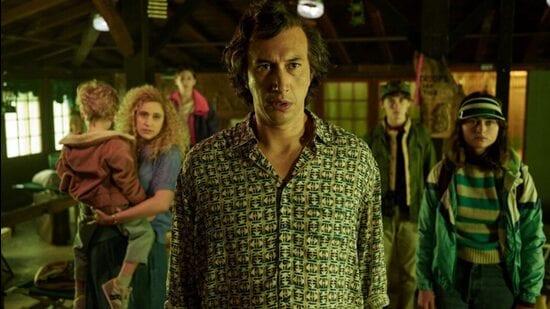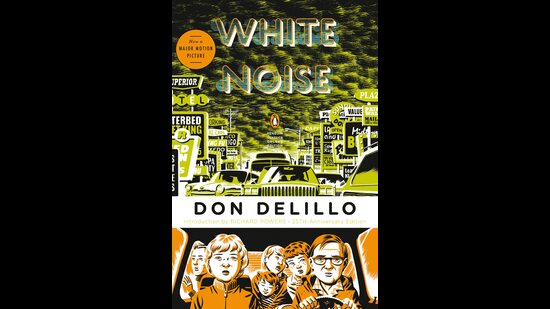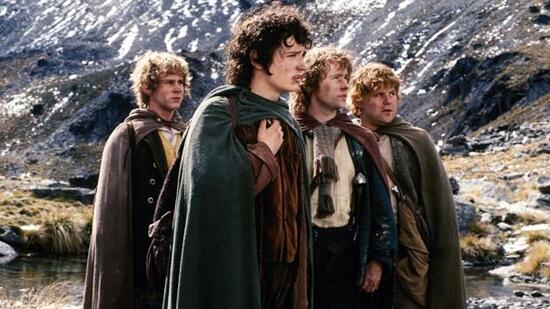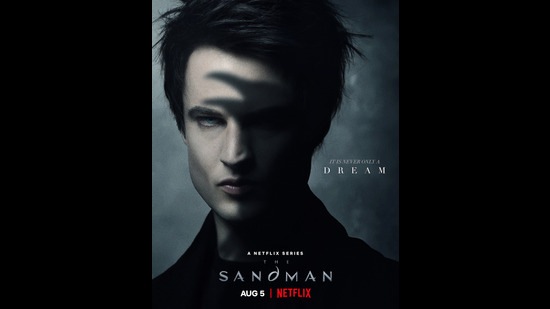Essay: On filming the “unfilmable” novel
Decoding the recent trend of cinema and TV tackling what were previously deemed as texts that just couldn’t be make that leap to a visual medium because of the original’s scope, scale and style
The most telling scene in Noah Baumbach’s White Noise comes right at the end. In a seven-minute choreographed sequence accompanying the closing credits, a supermarket transforms into a makeshift dancefloor with the cast grooving up and down the aisles to an LCD Soundsystem anthem. “I need a new party to represent my needs,” sings James Murphy. “I need a new body to push away the end.” What Don DeLillo imagined in his novel as shoppers wandering in a “fragmented trance” in the hopes of finding comfort in consumption, Baumbach reimagines as a dance. It is a slight tweak, but an effective one for the medium he is adapting. The scene lends the film the hypnotic rhythm and satirical edge of DeLillo’s prose: about a dysfunctional family allaying their deathly anxieties through the distractions of consumerism, technology, entertainment and conspiracy theories. If only everything preceding the closing scene was just as striking, all prior concerns about the post-modern classic being “unfilmable” may have been put to rest. In the process of marshalling a novel of around 320 pages into a film of around two hours, Baumbach ends up with an impoverished spectre of a source material rich in symbolism. What kneecaps the film is the somewhat awkward literalisation of DeLillo’s ideas and sometimes full throated announcement of his themes. The result is an adaptation that is neither clever nor funny enough to stand on its own merits.


All the same, the challenge of the “unfilmable” novel remains catnip for the more intrepid directors as the streamers double down on their wars, the studios look to keep up, and TV yearns for more prestige. As long as the directors are afforded creative control and the necessary resources, the challenge doesn’t scare them away as easily as it may once have. Bringing White Noise or Neil Gaiman’s The Sandman or Isaac Asimov’s Foundation series to the screen may have seemed like a fool’s errand a decade ago. Yet, here we are.
Adapting a book resistant to adaptation is one thing. Adapting it well is a whole other. The degree of success varies from project to project. No A for effort or full marks for good intentions here. Not when filmmakers and show runners have more resources at their disposal than their predecessors did. To be sure, the challenge is still a daunting one. Some obstacles are easier overcome than others.
For what earns a book the “unfilmable” tag can be boiled down to matters of scope, scale and style. How does one approach the intimidating scale of world-building found in Foundation, Dune or The Wheel of Time? How does one convey the socially unacceptable explicitness of Lolita, Tropic of Cancer or Portnoy’s Complaint without provoking the certification folks and ending up with sterile adaptations? How does one translate the untranslatable qualities peculiar to the written medium: consider the destabilising styles of Ulysses, the internal focalization of To the Lighthouse, or the typographical devilry of House of Leaves? Where does one even start when the three roadblocks of scope, scale and style coalesce into one terrifying mass as they do in Gravity’s Rainbow and Dhalgren?

Of the three, scale has been the easier to overcome. Peter Jackson paved the way by streamlining The Lord of The Rings into a ground-breaking spectacle for the big screen. HBO did likewise with Game of Thrones for the small. More muscular adaptations of canonical texts in speculative fiction have since followed. Streaming platforms have galvanized storytellers into adapting the more sprawling sagas beyond feature length. In the hope of luring more subscribers, Netflix, Amazon and Apple TV+ have brought in the biggest talent in front of and behind the camera with the promise of big bucks and big production values.
Scope presents an intriguing challenge. Characters took a back seat to ideas in Asimov’s Foundation. But given the character-driven nature of TV storytelling, show runners David S Goyer and Josh Friedman introduce a genetic dynasty of clones to afford some form of continuity, while still keeping the source material’s DNA intact. In the Dune series, Frank Herbert, much like Asimov, imagined his space politics saga playing out on a sweeping canvas. Denis Villeneuve avoids David Lynch’s mistake by splitting up the original novel into a two-part feature. In an effort to not overwhelm those unfamiliar with the text, Villeneuve distils it down to the essentials, doing away with interior monologues, some secondary characters and entire subplots. If the novel foreshadows events via epigraphs, the film rids this literary device, letting us experience the story alongside the protagonist as he lives it.
While novels can use interior monologues to reveal emotions or motivations, the problem for films has been to find a way to get inside a character’s head without resorting to voice overs. And while exposition doesn’t feel unnatural in a written work, it tends to take you out of a visualised work. This is often the case with many SF adaptations. At the same time, the solidity of the visual medium can weaken the mystery of abstract concepts. Dream, Death, Desire and Despair are all personified as sentient entities in Neil Gaiman’s mythopoeic fantasy The Sandman. The debut season of the Netflix series, despite merging the first two volumes of the comics into one, can neither match the narrative momentum nor the wild inventiveness of the source material.

Which brings us to style: the final frontier. If some authors possess more cine-resistant voices than others, it is because there are no viable equivalents to their formal innovations. To adapt Joyce, for instance, is to embrace the stylistic shape shifting and deal with the narrative itinerancy. To adapt Woolf is to find a visual approximation for her stream-of-consciousness technique. To adapt Pynchon is to design a narrative structure which formally mirrors his characters’ paranoia. The most challenging books to read are also the most challenging to film. Consider Gravity’s Rainbow, a novel that is written in so many different styles, features hundreds of characters, strands and digressions, and resists easy comprehension. The choice for the adapter is between turning it into an anthology series or compounding them all somehow into a film. The Wachowskis opted for the second approach with Cloud Atlas, based on David Mitchell’s epic novel comprised of six interconnected tales spanning generations and continents. The results were mixed: some parts felt overstretched; some shrunk.
Translating a written work for the visual medium without robbing it of its intrinsic power is a formidable task. The template to follow may be that set by David Cronenberg, who has found a happy middle ground balancing the novelist’s voice and his own. And he has done it thrice so far. Naked Lunch was the litmus test. William S. Burroughs plunged readers into an addict’s consciousness with a disorienting series of graphic sexual and violent episodes. Instead of a straightforward take, Cronenberg opted for a meta-remix of sorts, combining elements from Burroughs’ fiction and his life. The result was a film that contributes to our understanding of both: the author and the filmmaker who share a fascination for decay, transformation, the mind–body schism and altered states. Cronenberg’s take on JG Ballard’s Crash could very well be considered the yardstick: it is a cold, detached film that befits the novel’s stimulation-numbed future. As in Crash, the automobile plays a key role in Cosmopolis. The film takes place almost entirely inside a limousine carrying a 28-year-old billionaire through a traffic jam, while the world outside self-destructs. Cronenberg nails that same feeling of staccato strangeness you experience while reading Delillo’s novel. One can’t help but wonder how he might have approached White Noise. Villeneuve seems to have found the alchemy for unfilmable sci-fi texts, having struck gold twice. Before Dune, he turned Ted Chiang’s short story, Story of Your Life, into a deeply thoughtful film about the nature of language and our perception of time. He is slated to take on Arthur C Clarke’s Rendezvous with Rama soon. Also hot on the heels is a Netflix adaptation of Liu Cixin’s The Three-Body Problem from the makers of Game of Thrones.
What DeLillo meant by “white noise” is the sensation of constant distractions in this media-saturated age. Just as it does in his novel, pop culture works as a form of shorthand throughout Pynchon’s work. References to films, shows, and music abound. Characters burst into song. Be it V., The Crying of Lot 49 or Gravity’s Rainbow, the work may seem unfilmable but the vision is still cinematic. When it comes to the literary anarchy of Pynchon’s work, you need a filmmaker who welcomes the chaos, not mitigates it. Like Paul Thomas Anderson, whose adaptation of Inherent Vice only gets better with each rewatch. Thought it may be Pynchon’s most accessible novel, making it accessible for the screen is an entirely different matter. Recasting a minor character as the narrator to guide us through Pynchon’s narcotic vision of noir was a genius move on PTA’s part.

But how do you sell a streamer or studio on adapting more Pynchon? Mark Z Danielewski’s debut novel House of Leaves may be the toughest sell, with stories within stories, footnotes within footnotes, a house that appears to expand internally, and a manuscript to a film that doesn’t exist. Fonts change as unreliable narrators change. Colours too. The appeal of the novel is so inextricably tied to the appeal of the written word and the experience of reading, adapting it just seems futile. By taking a stab at it, you don’t want to end up with an illustrated audiobook. Not to be a media essentialist, but it is best to file it under “Do Not Attempt” alongside Finnegan’s Wake. For those foolhardy enough to attempt, perhaps the best approach is to take a leaf out of Charlie Kaufman’s Adaptation.: write themselves into the film as a screenwriter hitting a creative brick wall in the efforts to bring a stubbornly hostile novel to the big screen. Or as Terry Gilliam did not as cleverly in The Man Who Killed Don Quixote, satirizing his own 30-year quest to adapt the Cervantes classic.
So many literary gems are waiting to be filmed. Imagine Joanna Hogg taking on To the Lighthouse, David Robert Mitchell taking on Gravity’s Rainbow, or the Wachowskis taking on Ursula K Le Guin’s The Left Hand of Darkness. Just daydreaming about all the as-yet-unfilmed adaptations makes for a fun pastime. For no book is theoretically unfilmable. All it needs is a creatively resourceful filmmaker.
Prahlad Srihari is a film and pop culture writer. He lives in Bangalore.





